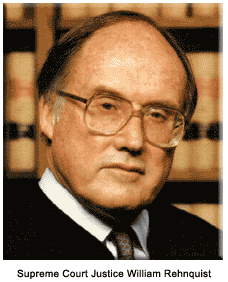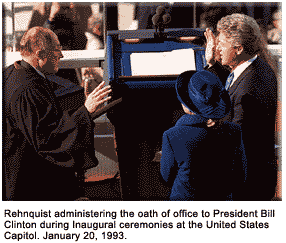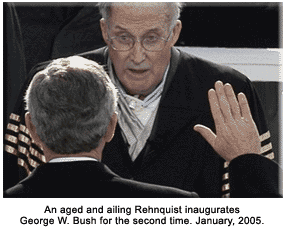Chief Justice William Hubbs Rehnquist, who first took a seat on the bench of the Supreme Court as an associate justice in 1972, will be most remembered for his staunchly conservative views and support of states` rights in the face of a liberal-leaning court bearing the likes of such well-known former members as William Brennan, William O. Douglas, and Thurgood Marshall.
Early in his career on the court, Rehnquist argued vociferously that the Equal Protection Clause of the Fourteenth Amendment, was interpreted by his fellow justices with far too broad a scope. He espoused a position that the clause had "only marginal application beyond cases of racial discrimination." Previously, the court had held that state-sponsored discrimination against illegitimate children, resident aliens, and women should be scrutinized under the clause.
 Rehnquist also was vocal in his minority position in Roe v. Wade, dealing with a woman`s right to an abortion. He authored a scathing opposing viewpoint, writing, "To reach its result [of allowing abortions as a constitutional right], the court necessarily has had to find within the scope of the Fourteenth Amendment, a right that was apparently completely unknown to the drafters of the Amendment."
Time has taken its toll on Rehnquist. In 1977, he injured his back and had to be hospitalized. During the next four years, he inadvertently became addicted to his medications and had to undergo rehabilitation at George Washington University Hospital. In October 2004, he was diagnosed with thyroid cancer, which led to speculation about his impending retirement.
The early years
William Hubbs Rehnquist was born into a conservative Milwaukee, Wisconsin-area family in 1924. His first exposure to the national political scene was the fates of Herbert Hoover, Alf Landon, and Wendell Willkie, who became his election-losing role models.
One anecdote is told that, when William was in grade school during the Franklin D. Roosevelt administration, he was asked by his teacher what his future plans were. Rehnquist responded, "I`m going to change the government."
Following high school, he spent a year at Kenyon College, an all-male, liberal arts school in central Ohio. During World War II, he entered the Army Air Force and served as a weather observer in North Africa.
Rehnquist took advantage of the G.I. Bill after the war to earn his bachelor`s and master`s degrees in political science from Stanford University in 1948. He followed that up with another master`s degree in government from Harvard University in 1950, then returned to Stanford to enter law school.
Rehnquist, who was in the same class as Sandra Day O`Connor, finished first in his class, garnering a comment from an instructor as being "the outstanding student of his law school generation." He also won begrudging respect from his liberal classmates for being a "formidable advocate of the conservative point of view on political issues."
Rehnquist received his first big break in 1951 when Justice Robert Jackson came to Stanford to dedicate a new law school building. Rehnquist arranged to be interviewed, then landed the plum position of Jackson`s law clerk. It was at that time he met and was befriended by Justice Felix Frankfurter, an avowed liberal, but accessible to discuss matters of law.
Rehnquist married Natalie Cornell, whom he had met at Stanford in 1953. They chose Phoenix, Arizona, as their home, and William began to practice law in the private sector. In 1957, he wrote an article for U.S. News and World Report, in which he reprimanded the ultra-liberal stance of some law clerks, how they influenced political philosophy, and charged them with political bias regarding which cases the court might decide.
In 1964, Rehnquist campaigned for Barry Goldwater while meeting such influential political figures as Richard Kleindienst. When Richard Nixon was elected president in 1968, Kleindienst was named the deputy attorney general, who in turn named Rehnquist as assistant attorney general in the Office of Legal Council for the Justice Department.
Kleindienst and Rehnquist, as well as Attorney General John Mitchell, were responsible for screening candidates for Supreme Court nominations. When John Marshall Harlan II retired in 1971, Mitchell decided that, following a period of disagreement over other possibilities, Rehnquist would be Nixon`s nominee.
Rehnquist also was vocal in his minority position in Roe v. Wade, dealing with a woman`s right to an abortion. He authored a scathing opposing viewpoint, writing, "To reach its result [of allowing abortions as a constitutional right], the court necessarily has had to find within the scope of the Fourteenth Amendment, a right that was apparently completely unknown to the drafters of the Amendment."
Time has taken its toll on Rehnquist. In 1977, he injured his back and had to be hospitalized. During the next four years, he inadvertently became addicted to his medications and had to undergo rehabilitation at George Washington University Hospital. In October 2004, he was diagnosed with thyroid cancer, which led to speculation about his impending retirement.
The early years
William Hubbs Rehnquist was born into a conservative Milwaukee, Wisconsin-area family in 1924. His first exposure to the national political scene was the fates of Herbert Hoover, Alf Landon, and Wendell Willkie, who became his election-losing role models.
One anecdote is told that, when William was in grade school during the Franklin D. Roosevelt administration, he was asked by his teacher what his future plans were. Rehnquist responded, "I`m going to change the government."
Following high school, he spent a year at Kenyon College, an all-male, liberal arts school in central Ohio. During World War II, he entered the Army Air Force and served as a weather observer in North Africa.
Rehnquist took advantage of the G.I. Bill after the war to earn his bachelor`s and master`s degrees in political science from Stanford University in 1948. He followed that up with another master`s degree in government from Harvard University in 1950, then returned to Stanford to enter law school.
Rehnquist, who was in the same class as Sandra Day O`Connor, finished first in his class, garnering a comment from an instructor as being "the outstanding student of his law school generation." He also won begrudging respect from his liberal classmates for being a "formidable advocate of the conservative point of view on political issues."
Rehnquist received his first big break in 1951 when Justice Robert Jackson came to Stanford to dedicate a new law school building. Rehnquist arranged to be interviewed, then landed the plum position of Jackson`s law clerk. It was at that time he met and was befriended by Justice Felix Frankfurter, an avowed liberal, but accessible to discuss matters of law.
Rehnquist married Natalie Cornell, whom he had met at Stanford in 1953. They chose Phoenix, Arizona, as their home, and William began to practice law in the private sector. In 1957, he wrote an article for U.S. News and World Report, in which he reprimanded the ultra-liberal stance of some law clerks, how they influenced political philosophy, and charged them with political bias regarding which cases the court might decide.
In 1964, Rehnquist campaigned for Barry Goldwater while meeting such influential political figures as Richard Kleindienst. When Richard Nixon was elected president in 1968, Kleindienst was named the deputy attorney general, who in turn named Rehnquist as assistant attorney general in the Office of Legal Council for the Justice Department.
Kleindienst and Rehnquist, as well as Attorney General John Mitchell, were responsible for screening candidates for Supreme Court nominations. When John Marshall Harlan II retired in 1971, Mitchell decided that, following a period of disagreement over other possibilities, Rehnquist would be Nixon`s nominee.
 After considerable contention in the Senate, Rehnquist was confirmed.
Rehnquist on the Supreme Court
Rehnquist quickly became known as the most conservative of the justices, even with three other Republican appointments on the bench. He was destined to fight numerous battles over the Fourteenth Amendment, arguing for a narrow point of view, not the "spirit" of the law, as he championed states` rights over congressional edicts.
As the tide of Liberalism ebbed, Rehnquist led the neo-conservative wing that was intent on reining in Congress`s powers, wielding a sharp sword to strike down portions of laws that were deemed to exceed the bounds of congressional authority granted by the Constitution. In 1975, in National League of Cities v. Usery, Rehnquist invoked the Tenth Amendment to invalidate a federal statute that controlled the hours and wages of state government employees, thus returning that power to the states.
As then Chief Justice Warren Burger prepared to retire in 1986, President Ronald Reagan announced that he would nominate Rehnquist for the vacant post. That provoked an angry protest from liberals in the Senate, including Senator Edward Kennedy. Kennedy charged Rehnquist for having an "appalling record on race," while some newspaper editors and columnists saw him as a right-wing extremist.
As Senate proceedings wore on, Rehnquist came under scrutiny for a memo he composed as a law clerk for Justice Jackson. Supposedly writing for Jackson, he urged the "separate but equal" concept argued in Brown vs. Board of Education be maintained and not overruled. The Senate found those and other minor incidents to be "ancient history," and not enough evidence to prevent Rehnquist from winning confirmation.
The Rehnquist court
Rehnquist`s idea of the chief justice`s role was laid down in a 1976 speech when he alluded to Charles Evans Hughes. Rehnquist said Hughes believed in a "unanimity of decision [which] contributed to public confidence in the Court." Hughes would often side with the majority, except in cases involving "high matters of priciple."
In 1987, during Rehnquist`s second term, he was lauded by Justice Harry Blackmun as being a "splendid administrator in conference." Exemplifying the Hughes philosophy, Rehnquist demonstrated his own flexibility by siding with the liberals of the court when he agreed that the firing of a homosexual CIA agent should go to judicial review. He also supported the First Amendment rights of Hustler magazine to disparage a public figure with off-color buffoonery.
In 1988, in Morrison v. Olson, Rehnquist wrote the majority opinion that confirmed the right of Congress to name independent counsels to "investigate and prosecute high government officials," much to the chagrin of the Reagan administration.
Rehnquist continued to cajole the court into siding with the states in a number of key decisions. In 1992, in New York v. United States and Printz v. United States (1997) the court ruled, based on the Tenth Amendment, that the federal government cannot force states to "enact or administer a federal regulatory program."
In addition, in United States v. Lopez (1995), the court limited Congress`s power once again by overruling the conviction of a high school student who had carried a gun into a "Gun-free Zone." The student had been arrested and charged under a federal statute, which, the court ruled, exceeded the authority given to Congress by Article 1, Section 8 of the Constitution (known as the "Commerce Clause").
The same logic was applied to the Violence Against Women Act of 1994, which Congress drafted under the far-reaching guise of the Commerce Act. The case, United States v. Morrison, et al. (2000), continues to be a landmark decision described by the New York Times as a "Violation Against the Constitution."
After considering the degree of interstate commerce involved compared to the Lopez case, Rehnquist wrote the majority opinion, saying, "We accordingly reject the argument that Congress may regulate noneconomic, violent criminal conduct based solely on the conduct`s aggregate effect on interstate commerce."
The court was not saying the wording in the laws was erroneous per se, but that the states, not Congress, had to make their own laws regarding such matters.
After considerable contention in the Senate, Rehnquist was confirmed.
Rehnquist on the Supreme Court
Rehnquist quickly became known as the most conservative of the justices, even with three other Republican appointments on the bench. He was destined to fight numerous battles over the Fourteenth Amendment, arguing for a narrow point of view, not the "spirit" of the law, as he championed states` rights over congressional edicts.
As the tide of Liberalism ebbed, Rehnquist led the neo-conservative wing that was intent on reining in Congress`s powers, wielding a sharp sword to strike down portions of laws that were deemed to exceed the bounds of congressional authority granted by the Constitution. In 1975, in National League of Cities v. Usery, Rehnquist invoked the Tenth Amendment to invalidate a federal statute that controlled the hours and wages of state government employees, thus returning that power to the states.
As then Chief Justice Warren Burger prepared to retire in 1986, President Ronald Reagan announced that he would nominate Rehnquist for the vacant post. That provoked an angry protest from liberals in the Senate, including Senator Edward Kennedy. Kennedy charged Rehnquist for having an "appalling record on race," while some newspaper editors and columnists saw him as a right-wing extremist.
As Senate proceedings wore on, Rehnquist came under scrutiny for a memo he composed as a law clerk for Justice Jackson. Supposedly writing for Jackson, he urged the "separate but equal" concept argued in Brown vs. Board of Education be maintained and not overruled. The Senate found those and other minor incidents to be "ancient history," and not enough evidence to prevent Rehnquist from winning confirmation.
The Rehnquist court
Rehnquist`s idea of the chief justice`s role was laid down in a 1976 speech when he alluded to Charles Evans Hughes. Rehnquist said Hughes believed in a "unanimity of decision [which] contributed to public confidence in the Court." Hughes would often side with the majority, except in cases involving "high matters of priciple."
In 1987, during Rehnquist`s second term, he was lauded by Justice Harry Blackmun as being a "splendid administrator in conference." Exemplifying the Hughes philosophy, Rehnquist demonstrated his own flexibility by siding with the liberals of the court when he agreed that the firing of a homosexual CIA agent should go to judicial review. He also supported the First Amendment rights of Hustler magazine to disparage a public figure with off-color buffoonery.
In 1988, in Morrison v. Olson, Rehnquist wrote the majority opinion that confirmed the right of Congress to name independent counsels to "investigate and prosecute high government officials," much to the chagrin of the Reagan administration.
Rehnquist continued to cajole the court into siding with the states in a number of key decisions. In 1992, in New York v. United States and Printz v. United States (1997) the court ruled, based on the Tenth Amendment, that the federal government cannot force states to "enact or administer a federal regulatory program."
In addition, in United States v. Lopez (1995), the court limited Congress`s power once again by overruling the conviction of a high school student who had carried a gun into a "Gun-free Zone." The student had been arrested and charged under a federal statute, which, the court ruled, exceeded the authority given to Congress by Article 1, Section 8 of the Constitution (known as the "Commerce Clause").
The same logic was applied to the Violence Against Women Act of 1994, which Congress drafted under the far-reaching guise of the Commerce Act. The case, United States v. Morrison, et al. (2000), continues to be a landmark decision described by the New York Times as a "Violation Against the Constitution."
After considering the degree of interstate commerce involved compared to the Lopez case, Rehnquist wrote the majority opinion, saying, "We accordingly reject the argument that Congress may regulate noneconomic, violent criminal conduct based solely on the conduct`s aggregate effect on interstate commerce."
The court was not saying the wording in the laws was erroneous per se, but that the states, not Congress, had to make their own laws regarding such matters.
 Summary
When future generations look back at the life and accomplishments of William Rehnquist, some will conclude, "Well done, my good and faithful servant." Others will say his tenure on the bench retarded social progress. Regardless of history`s ultimate judgement, there was a little boy from Wisconsin who unabashedly declared, "I`m going to change the government." Over a period of more than 30 years on the bench of the highest court in the land, he did.
William Rehnquist, 80, died at home of thyroid cancer on September 4, 2005.
Summary
When future generations look back at the life and accomplishments of William Rehnquist, some will conclude, "Well done, my good and faithful servant." Others will say his tenure on the bench retarded social progress. Regardless of history`s ultimate judgement, there was a little boy from Wisconsin who unabashedly declared, "I`m going to change the government." Over a period of more than 30 years on the bench of the highest court in the land, he did.
William Rehnquist, 80, died at home of thyroid cancer on September 4, 2005.